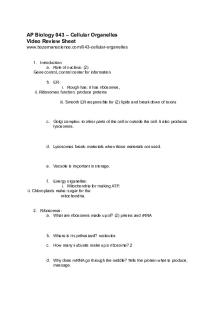Bozeman Cellular Organelles Answer Key PDF

| Title | Bozeman Cellular Organelles Answer Key |
|---|---|
| Author | Akshaya Sree Arumugam |
| Course | Molecular Biology |
| Institution | Harvard University |
| Pages | 3 |
| File Size | 78 KB |
| File Type | |
| Total Downloads | 72 |
| Total Views | 151 |
Summary
THis document is very very very very very very very very very very very very very very very very very very very very very very very very very very helpful!...
Description
AP Biology 043 – Cellular Organelles Video Review Sheet www.bozemanscience.com/043-cellular-organelles
1. Introduction: a. Role of nucleus: (2) Gene control, control center for information b. ER : i. Rough has: it has ribosomes, ii. Ribosomes function: produce proteins iii. Smooth ER responsible for (2) lipids and break down of toxins
c. Golgi complex: to other parts of the cell or outside the cell. It also produces lysosomes.
d. Lysosomes break: materials when those materials not used.
e. Vacuole is important in storage.
f.
Energy organelles: i. Mitochondria for making ATP. ii. Chloroplasts make: sugar for the mitochondria.
2. Ribosomes: a. What are ribosomes made up of? (2) prteins and rRNA
b. Where is it synthesized? nucleulos c. How many subunits make up a ribosome? 2
d. Why does mRNA go through the middle? Tells the protein what to produce, message.
Review Sheet for Contributed by /mslittenbiology
AP Biology 043 Winnie Litten Twitter-‐@mslittenbiology
– —
Cellular YouTube
Organelles -‐
3. Endoplasmic Reticulum: a. What is the ER usually attached to? Outside of the nucleus b. Rough ER has ribosomes on it so it can synthesize proteins
c. Smooth ER is where lipids are synthesized. (Mentioned above) d. The function of the ER is to be a lattice so cells can build things.
4. Golgi Complex: a. Tell about some of the accomplishments of Camillo Golgi he was really good at staining ells to figure out how organelles work.
b. Purpose: takes information that is made in the ER and takes the information that is made in the ER and ships them out around the cell.
5. Lysosome: a. Purposes: (3 discussed) i. Digest material ii. Dissolve un-functioning mitochondria iii. Kill cells.
b. Why is it referred to as the “suicide sack”? enzymes located in the lysosome can kill the cell that it is located.
6. Mitochondria: a. Purpose: Energy production ATP.
b. Why is their folding on the cristae and why is that significant? To increase surface agrea, this allows mitochondria to make more ATP.
7. Vacuole Purposes: i. ii. iii. iv. v.
Storage Store materials Pigments Chemicals Cell growth
8. Chloroplast: a. Purpose: i. ii.
Photosynthesis Create sugars
b. The reason there is increased surface area is for: (2) absorb more light and increase chemical reactions.
Review Sheet for Contributed by /mslittenbiology
AP Biology 043 Winnie Litten Twitter-‐@mslittenbiology
– —
Cellular YouTube
Organelles -‐...
Similar Free PDFs

Cellular Respiration 2 (Answer)
- 6 Pages

Cellular Respiration (Answer)
- 7 Pages

13 Cellular Respiration-KEY
- 8 Pages

Lab2 Sampling KEY - Answer key
- 9 Pages

Homework #3 KEY - answer key
- 6 Pages

Membranous Organelles
- 6 Pages

Bozeman Sci Enzymes Wksht
- 2 Pages
Popular Institutions
- Tinajero National High School - Annex
- Politeknik Caltex Riau
- Yokohama City University
- SGT University
- University of Al-Qadisiyah
- Divine Word College of Vigan
- Techniek College Rotterdam
- Universidade de Santiago
- Universiti Teknologi MARA Cawangan Johor Kampus Pasir Gudang
- Poltekkes Kemenkes Yogyakarta
- Baguio City National High School
- Colegio san marcos
- preparatoria uno
- Centro de Bachillerato Tecnológico Industrial y de Servicios No. 107
- Dalian Maritime University
- Quang Trung Secondary School
- Colegio Tecnológico en Informática
- Corporación Regional de Educación Superior
- Grupo CEDVA
- Dar Al Uloom University
- Centro de Estudios Preuniversitarios de la Universidad Nacional de Ingeniería
- 上智大学
- Aakash International School, Nuna Majara
- San Felipe Neri Catholic School
- Kang Chiao International School - New Taipei City
- Misamis Occidental National High School
- Institución Educativa Escuela Normal Juan Ladrilleros
- Kolehiyo ng Pantukan
- Batanes State College
- Instituto Continental
- Sekolah Menengah Kejuruan Kesehatan Kaltara (Tarakan)
- Colegio de La Inmaculada Concepcion - Cebu








